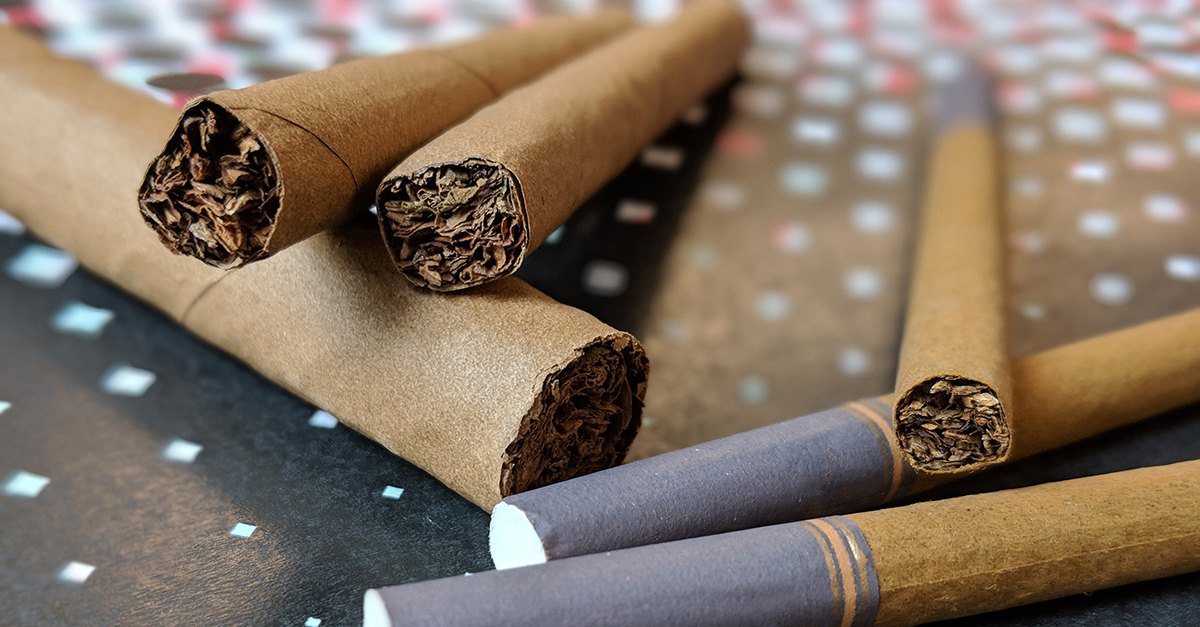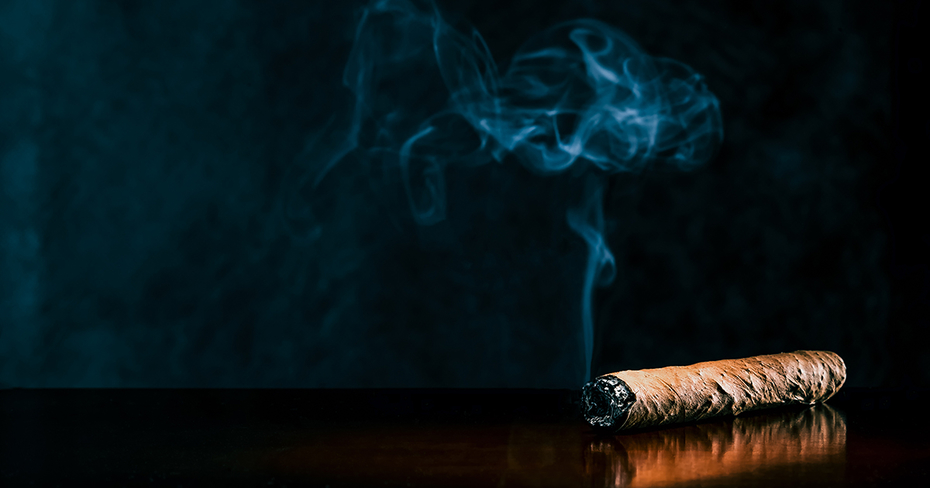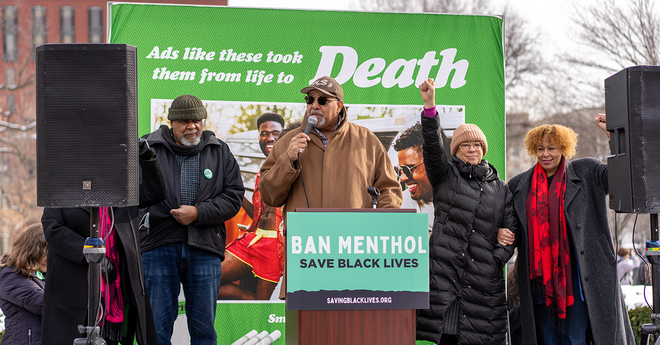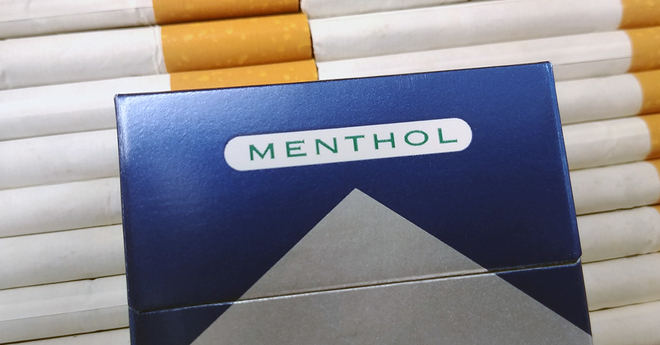Cigars: Facts, stats and regulations
Cigars are defined in the United States tax code as “any roll of tobacco wrapped in leaf tobacco or in any substance containing tobacco” that does not meet the definition of a cigarette.
At least three major cigar products — little cigars, large cigars, and cigarillos — exist in the category.
- Little cigars (small cigars) resemble cigarettes and generally have a filter like a cigarette. While cigarettes are wrapped in white paper, little cigars are wrapped in brown paper that contains some tobacco leaf. They are frequently sold as singles or in packs of 20 and have been referred to as “cigarettes in disguise” because they are similar in size and shape. They are the smallest of all cigars, weighing three pounds per thousand cigars or less, and have nicotine levels ranging from 10.3-19.1 mg/g.
- Traditional (large) cigars are larger than little cigars and are also referred to as “stogies.” They are often separated into three portions (wrapper, binder, and filler). Large, traditional cigars are larger than little cigars and cigarillos, weighing more than the 3 lbs/1,000 limit for little cigars, and contain between 6.76-28.6 mg/g of nicotine.
- The term “premium cigars” to describe large, traditional cigars is a marketing construct developed by the tobacco industry. There is no single, consistent definition of premium cigars.
- Cigarillos are longer, slimmer versions of large cigars, weigh more than 3 lbs./1,000 cigars and are classified as large cigars by federal tax code, which receive a better tax rate. They are mostly machine-made, more affordable than cigarettes, and may or may not have filters or tips. Nicotine levels range from 4.84-12.0 mg/g.
Other than the weight regulations separating little cigars from large cigars, product branding and categorization in the actual market is widely variable. Some products are labelled as cigarillos but are larger than some products labeled as large cigars, and some large cigars have the physical characteristics of cigarillos.
Little cigars, cigarillos, and large cigars are sold in a variety of flavors, including menthol as well as candy and fruit flavors, such as sour apple, cherry, grape, and chocolate.

PATTERNS OF USE
Between 2000 and 2015, total cigarette consumption rates among Americans declined by 38.7%, while consumption rates of cigars increased dramatically (by 85.2%). Overall, 4.5% of the U.S. population reported smoking cigars within the last 30 days in 2018. The rates of use among youth are particularly troubling. While the prevalence of cigar use among high school students in the U.S. has historically been lower than cigarette use, since 2016, cigar use has been very close to or even surpassed cigarette use, according to the National Youth Tobacco Survey (NYTS). NYTS data show that past 30-day cigar use was 2.1% among all high school students and 0.6% among all middle school students in 2021. As a result of the Family Smoking Prevention and Tobacco Control Act in 2009, the Food and Drug Administration banned flavored cigarettes, except menthol. Because FDA did not at that time have jurisdiction over cigars, cigar manufacturers took advantage of this loophole and began to heavily market and promote flavored cigar products, potentially contributing to the observed increase in use among youth. One study found that after the cigarette flavor ban took effect, many youth simply switched to flavored cigars and menthol cigarettes. In April 2022, FDA proposed rules to remove menthol cigarettes and all flavored cigars from the market.
YOUTH
Declines in cigar use have not been as steep as declines in cigarette use. Current, or past 30-day, cigar use was 2.1% among all high school students and 0.6% among all middle school students in 2021, according to the National Youth Tobacco Survey. By comparison, current cigarette use was 1.9% among high school students and 1.0% among middle school students. In a separate survey of eighth, 10th, and 12th graders, 1.5% of youth smoked flavored little cigars and cigarillos and 1.3% of youth smoked regular little cigars and cigarillos in 2021. While surveys show that large, traditional cigar use among youth is lower than that of cigarettes, it is not insubstantial, as the industry has argued.
- An estimated 1,350 youth between the ages of 12 and 17 in the U.S. smoked their first cigar each day in 2018.
- Among middle and high schoolers who have never smoked cigars, 28% were curious about smoking cigars and 35.9% reported susceptibility to cigars.
- In 2021, among high school current cigar users, 20.7% used the product on 20 or more days in the past 30 days.
- Nearly half of youth past 30-day cigar users reported using blunts, cigars that are hollowed out and used to smoke marijuana.
Some subgroups of youth smoke cigars at higher rates.
- Among youth overall, cigar use is highest in males.
- Middle and high school students belonging to certain racial and ethnic groups smoke cigars at higher rates. According to 2021 NYTS data, Black youth currently used cigars at higher rates (3.1%) compared to white (1.4%) and Hispanic (0.9%) youth.
Flavored cigars are popular among youth, and remain on the market until FDA finalizes its 2022 proposed rule to remove flavored cigars. Cigars are available in many flavors that appeal to youth, including fruit, dessert, and alcoholic beverages.
- Less than 1% (0.6%) of all middle and high school students used flavored cigars in 2021. However, among current cigar smokers, 44% of middle and high school students used a flavored cigar in the past 30 days.
- Youth are smoking flavored little cigars (1.5%) at rates lower or equivalent than cigarettes (2.3%), regular little cigars (1.3%), or large cigars (1.5%). In 2021, among 12th grade students, 1.9% reported smoking flavored little cigars in the past 30 days. (2021 Monitoring the Future)
- Youth are more likely to use a flavored cigar the first time they try a cigar. In a survey of 12-17-year-olds fielded in 2017, 65% of tobacco users reported using flavored cigars as their first ever tobacco product.
- Nearly three-quarters — 73.8% — of past 30- day cigar users ages 12-17 said the leading reason for their cigar use was “because they come in flavors I like” followed by 58.2% who stated it was “because they are affordable.”
YOUNG ADULTS & ADULTS
Data from the 2018 National Survey on Drug Use and Health show that while cigarette use among U.S. adults has steadily declined since 2003, adult cigar use has remained almost flat.
- Adult cigar use is higher among younger adults. In the 2014 National Survey on Drug Use and Health, young adults ages 18-25 had the highest prevalence of past 30-day cigar use (8.6%) compared to youth ages 12-17 (1.7%) and adults 26 or older (4.1%).
- In 2018, an estimated 3,414 young adults between the ages of 18 and 25 initiated cigar smoking each day, compared to 1,465 adults aged 26 or older.
- In 2018-2019, daily cigar smoking was highest among filtered cigar users (42.1%) followed by those who used cigarillos (22.7%) and non-premium traditional cigars (14.1%), according to the 2022 NASEM report
- In 2018, more adult males report using cigar products “every day” or “some days” (6.8%) compared to adult females (1.1%). More African American adults reported using cigar products every day or some days (4.9%), compared to whites (4.1%) and Hispanics (2.8%).
- A national study of young adults ages 18- 24 found that marijuana use was strongly correlated with past 30-day little cigar and cigarillo use. In 2014, the prevalence of past 30-day blunt use among past 30-day cigar users was 49% for young adults ages 18-25 and 19.3% for adults ages 26 or older.
HEALTH EFFECTS
Cigars cost lives and pose significant economic costs.
- A 2014 study found that cigar smoking was responsible for approximately 9,000 premature deaths among adults aged 35 and older in the U.S. These deaths represented almost 140,000 years of potential life lost and monetary loss of $22.9 billion. A 2019 study found that the removal of flavored cigars from the market would result in an estimated 800 fewer cigar smoking-attributable deaths in the U.S. each year and 112,000 fewer cigar smokers in each cohort of 18 year olds.
- Cigar smoking is associated with a higher risk of oral, esophageal, laryngeal, and lung cancer. Cigar smokers have a marked increase in risk for chronic obstructive pulmonary disease (COPD) and experience higher mortality from COPD than do non-smokers.
- Though cigar smoke is generally similar to cigarette smoke, it contains higher levels of harmful constituents including tobacco-specific nitrosamines (TSNAs), NNK, carbon monoxide (CO), ammonia, and tar.
- Secondhand cigar smoke contains dangerous compounds and chemicals that pose significant health problems to cigar smokers and non-smokers. Cigar smoke contains higher concentrations of toxic and carcinogenic compounds than cigarette smoke.
- Most cigar smokers do inhale some amount of smoke and are unaware that they are doing it, even among those who do not intend to inhale. Regardless of how much inhalation actually takes place, studies show that because cigar smoke dissolves more easily in saliva than cigarette smoke, cigar users absorb smoke and nicotine from cigars even when they report no inhalation. Young consumers usually inhale the smoke of Black & Mild cigars, unlike large cigar smoke. Small cigar smoking is associated with smoke inhalation that leads to significant exposure to nicotine, carbon monoxide, and presumably other components of tobacco smoke. Removing the inner paper liner does not substantially reduce toxin exposure.

Some cigar smokers indicate that they either did not know whether cigars were more or less harmful than cigarettes or perceived cigars to be less harmful than cigarettes.
PERCEPTIONS OF CIGARS IN THE U.S.
Cigar users significantly underestimate the health risks of cigars.
- Some cigar smokers indicate that they either did not know whether cigars were more or less harmful than cigarettes or perceived cigars to be less harmful than cigarettes. These misperceptions of the health risks were higher in specific demographic groups — young adults and Black youth, in particular.
- In 2021, more students in eighth and 10th grades had high perceived risk of smoking one or more packs of cigarettes per day — 64.0% and 72.7% — compared to smoking little cigars or cigarillos regularly — 42.8% and 45.6%. More eighth and 10th grade students perceived greater risk in smoking one to five cigarettes per day — 39.5% and 72.7% — compared to smoking little cigars or cigarillos regularly.
- In a nationally representative sample of young adults ages 18-34, more respondents rated cigars as less risky than cigarettes (13.9%) than they rated other tobacco products, including noncombustible snus (10.0%) and other smokeless tobacco products (7.1%).
INDUSTRY MARKETING
Cigar smoking in the United States rose dramatically in the 1990s and 2000s, in part due to cigar marketing strategies. Cigar marketing is not subject to the same restrictions as cigarette marketing (see Policy section).
- Recent studies have shown that cigar companies package some small cigars to look similar to cigarettes and sell them in the same places that cigarettes are sold. They also use similar social media marketing tactics that cigarette companies use, as well as previous cigarette company marketing tactics, such as celebrity endorsements.
- So-called premium cigar companies use lifestyle magazines and festivals for promotion. Marketing strategies include sponsoring music festivals and promotion of their products with urban lifestyle and hip-hop and rock music.
- So-called premium cigar companies have online and social media presence not captured by traditional methods of tracking marketing expenditure.
- One study found that cigar, little cigar, and cigarillo advertising on the exterior of retail outlets is significantly more prevalent in neighborhoods with African Americans and young adults. This study also showed that little cigars and cigarillos are more available, cheaper, and highly advertised in African American neighborhoods.
- Little cigars and cigarillos are available as singles. By contrast, single cigarettes or “loosies,” which were popular in African American communities, were banned by the Family Smoking Prevention and Tobacco Control Act. Little cigars and cigarillos are also available in pack sizes of less than 20, with some available in two-packs, five-packs, and seven-packs. Small packs tend to be cheaper than cigarettes, which may appeal to price sensitive populations such as youth and low-socioeconomic status populations.
- The increased visibility of cigar smoking from advertising and promotional activities is “normalizing” cigar use. Tobacco companies promote cigar smoking as pleasurable, a symbol of status, wealth and class.
- So-called premium cigars are advertised and promoted as less harmful than other tobacco products and as having benefits that outweigh their adverse health effects.
- The U.S. population perceives cigar products overall to be harmful and addictive. However, there is no research that examines the knowledge of specific health effects of so-called premium cigars.

Swisher Sweets Artist Project
The 1998 Master Settlement Agreement and the 2009 Family Smoking Prevention and Tobacco Control Act prohibited cigarette and smokeless tobacco companies from sponsoring music, sports and other cultural events and creating branded merchandise because of evidence that linked these types of marketing tactics with youth tobacco use. Cigars are not bound by these restrictions, though the same concerns exist about the connection between these marketing tactics and youth tobacco use. A marketing campaign from cigar company Swisher Sweets is an example of how cigar companies take advantage of these loopholes in regulation.
Swisher Sweets Artist Project is a marketing campaign that holds music events with emerging artists, including pop-up performances in convenience stores — “Convenience Store Sessions” — and concerts in select cities called “Swisher Sweets Pack Nights.” These events are hosted across the country and are set against the backdrop of Swisher Sweets ads, displays and clothes. Tickets for some locations included a voucher for packs of certain Swisher Sweets cigars and cigarillos. At other pack night locations, attendees could get special gear and giveaways.
POLICY ENVIRONMENT
FDA REGULATION
In May 2016, the Food and Drug Administration (FDA) finalized its “deeming” regulation, asserting the agency’s authority to regulate little cigars, cigarillos, and so-called premium cigars, as well as components and parts such as rolling papers and filters. The FDA can now issue product standards to make all cigars less appealing, toxic, and addictive, and it can issue marketing restrictions like those in place for cigarettes, in order to keep cigars out of the hands of kids.
- The deeming regulation included requirements for pre-market review for cigars on the market between Feb. 15, 2007, and Aug. 8, 2016, as new tobacco products. Many of the cigars on the market today were in distribution prior to Feb. 15, 2007, and are therefore grandfathered, which means they don’t have go through the pre-market review process.
- For new products to receive marketing approval for a new product, a manufacturer would need to demonstrate that the new product would be “appropriate for the protection of the public health,” taking into account both the likelihood of new tobacco product initiation and the increased or decreased likelihood that existing users of current tobacco products would stop using such products.
- The addition of a new flavor should constitute a “new product,” so new flavors of cigars should go through the pre-market review process.
In August 2017, the FDA pushed back the compliance date for cigar manufacturers to submit pre-market applications to August 2021.
- In March 2018, a group of public health organizations, including Truth Initiative®, sued the FDA for unlawfully delaying the implementation of the deeming rule.
- In May 2019, a federal judge ruled that the FDA had acted illegally by allowing cigars to remain on the market without formally reviewing their impact on public health. The judge ordered the FDA to commence the statutorily required review by May 12, 2020, which was then extended to September 9, 2020, due to the coronavirus pandemic.
The cigar industry sued FDA regarding its ability to regulate so-called premium cigars.
- In August 2020, a US district court judge issued a ruling prohibiting FDA enforcement of the premarket review requirement for so-called premium cigars until after the agency considers developing a streamlined substantial equivalence process specifically for premium cigars. FDA has not done so as of yet. The court order defines premium cigars as cigars that meet the following criteria:
- Is wrapped in whole tobacco leaf;
- Contains a 100 percent leaf tobacco binder;
- Contains at least 50 percent (of the filler by weight) long filler tobacco (i.e., whole tobacco leaves that run the length of the cigar);
- Is handmade or hand rolled (i.e., no machinery was used apart from simple tools, such as scissors to cut the tobacco prior to rolling);
- Has no filter, nontobacco tip, or nontobacco mouthpiece;
- Does not have a characterizing flavor other than tobacco;
- Contains only tobacco, water, and vegetable gum with no other ingredients or additives; and
- Weighs more than 6 pounds per 1,000 units.
- In July 2022, the District Court further ruled that the application of the Deeming Rule to so-called premium cigars was arbitrary and capricious because the FDA did not have enough data to support the decision.
FLAVORS
In April 2022, FDA issued proposed rules to remove menthol cigarettes and characterizing flavors in all cigars. There are currently no federal restrictions on flavored cigars while the rule is being finalized.
- In March 2018, the FDA issued an advance notice of proposed rulemaking to request public comment to better understand the role that flavors in tobacco products play in attracting youth.
- In March 2019, the FDA proposed to remove any flavored cigars that were on the market as of Aug. 8, 2016, and met the definition of a new tobacco product. In January 2020, the FDA issued a final guidance, but it only applied to e-cigarettes and did not apply to flavored cigars.
- As of March 31, 2022, 361 United States jurisdictions have implemented some type of flavored tobacco sales restriction, most of which include flavored cigars.
- In 2020, Massachusetts banned the sale of all flavored tobacco products, including flavored cigars, except in cigar bars and hookah lounges. Maine has banned the sale of flavored non-premium cigars since 2007.
POINT OF SALE
There are few federal regulations around point-of-sale marketing practices for cigars.
- Some localities have implemented minimum prices and packaging for cigars.
- In New York City, cigars that cost less than $3 individually must be sold in packs of four or more and little cigars must be sold in packs of 20 ($4.35). Additionally, little cigars cannot be sold at retail for less than $13 per pack. Little cigars are taxed at the same rate as cigarettes.
- At least 175 municipalities in Massachusetts, including Boston, require single cigars to be sold for at least $2.50 and multi-packs of two or more cigars to be sold for at least $5.76
- Average price of single cigars in Massachusetts increased steadily each year from 2014 to 2018 ($1.35 to $1.64).
- Minneapolis requires a minimum price for cigars of $2.60 for a single cigar, $5.20 for a 2-pack, $7.80 for a 3-pack, and $10.40 for packs of 4 or more cigars.
- Several localities in California, including Berkeley, Fremont, San Diego County, and Sonoma County, have implemented minimum pricing and packaging laws for cigars.
- New Jersey, New York State, and some localities such as San Diego County, California; Chicago, Illinois; St. Paul, Minnesota; Washington County, Oregon; and Providence, Rhode Island, have prohibited the redemptions of coupons and discounts for all tobacco products including cigars.
TAXATION
- The Children’s Health Insurance Program Reauthorization Act (CHIPRA) of 2009 increased federal excise taxes on little cigars from $0.04 to $1.01 per pack of 20 — bringing the federal tax rate on little cigars on par with cigarettes.
- In 2009, following the federal tax increase on all tobacco products, several little cigar brands increased their weight slightly to qualify as “large cigars” under the federal tax code to receive a better tax rate. With this preferential tax treatment, these products became significantly cheaper.
- Cigar manufacturers increased weight by using fillers, such as the clay found in kitty litter, or stuffing the products with more tobacco to tip the scales in their favor. The new “large cigar” can appear almost identical to a “small cigar,” which resembles a typical cigarette and can cost as little as 7 cents per cigar. Small cigar manufacturers have capitalized on the visual similarities of small cigars and cigarettes in marketing. These tactics demonstrate the importance of product review.
- The federal Tax Code breaks cigars into two categories for the purpose of excise taxes: “small cigars” which are the same size as cigarettes (three pounds or less per thousand sticks), and “large cigars” that cover every other type of cigar that is larger than three pounds per thousand sticks.
- All states, except Florida and Pennsylvania, impose an excise tax on cigars as of 2022.
WARNING LABELS
- In 2001, the Federal Trade Commission (FTC) established five cigar warnings for the top six selling brands, based on data from the National Cancer Institute Monograph on Cigars.
- The FDA’s final “deeming” regulation extends these same warnings to all cigar brands and added an additional warning. On a rotating basis, cigar manufacturers must include the following six warnings statements on all cigar packages and advertisements:
- WARNING: This product contains nicotine. Nicotine is an addictive chemical.
- WARNING: Cigar smoking can cause cancers of the mouth and throat, even if you do not inhale.
- WARNING: Cigar smoking can cause lung cancer and heart disease.
- WARNING: Cigars are not a safe alternative to cigarettes.
- WARNING: Tobacco smoke increases the risk of lung cancer and heart disease, even in nonsmokers.
- WARNING: Cigar use while pregnant can harm you and your baby. (Or, as an optional alternative statement: SURGEON GENERAL WARNING: Tobacco Use Increases the Risk of Infertility, Stillbirth, and Low Birth Weight.)
- These warnings were to be placed on two “principal display panels” of the packaging and were to cover at least 30% of each of the panels they are affixed to.
- Retailers who sold individual, unpackaged cigars were to display a sign with all six warning statements that is a minimum size of 8.5-by-11 inches either on or within 3 inches of each cash register.
- These warning statements were set to become effective May 10, 2018, but were placed on hold pending litigation by the cigar industry. In September 2020, a U.S. district court judge ruled against the FDA and lifted the requirement for health warnings on cigar packages and advertisements.
YOUTH ACCESS AND MINIMUM AGE OF SALE
- The FDA’s final “deeming” regulation established a federal minimum age of sale at 18 years old for all tobacco products, including cigars. In December 2019, the U.S. adopted a law raising the federal minimum age of sale for all tobacco products to 21 years old, effective immediately. Federal law requires retailers to check photo ID of everyone under age 27 who attempts to purchase cigars. Vigorous enforcement of these age requirements is necessary to reduce youth uptake.
- The FDA’s final “deeming” regulation banned vending machine sales except in facilities where only those over 18 years old are allowed. The final rule also banned free samples of all cigars and their components or parts.
- The Family Smoking Prevention and Tobacco Control Act required the FDA to issue regulations to establish age verification requirements for the Internet and other non-face-to-face purchase of any tobacco products. However, the FDA has yet to implement this set of regulations.
ACTION NEEDED: CIGARS
FEDERAL ACTION NEEDED
- Extend marketing restrictions on cigarettes to cigars: The FDA must restrict cigar marketing so that it does not target or appeal to youth. Specifically, the agency must immediately extend the marketing restrictions that apply to cigarettes to cigars. These include prohibitions on:
- Sponsorships of sports and cultural events
- Self-service access to the products (i.e., keeping the products behind the counter)
- Free gifts with purchase, other than tobacco products (i.e., no branded t-shirts, hats, etc.)
- FDA review: The FDA must enforce its authority to immediately remove from the market any cigar product introduced to the market after February 15, 2007 that did not submit a substantial equivalence report or premarket tobacco product application by September 9, 2020.
- Flavor restrictions: We know flavors have overwhelmingly been used to attract those who have not previously used tobacco products. The FDA must finalize its proposed rule banning all flavored cigars as expeditiously as possible, and implement the rule simultaneously, or as close to simultaneously as possible, with the proposed rule to remove menthol cigarettes.
- Internet sales: The FDA should prohibit all non-face-to-face sales, along with internet sales, of all tobacco products, including cigars.
- Premium cigars: Cigars, no matter the size or the price, are addictive and deadly combustible products and the decision to regulate so-called premium cigars should not be revisited. While some regulatory approaches may need to adapt to the nature of the product and retail environment (for example, warning requirements for cigars sold as unpackaged single sticks), there is no evidence to support exempting a combustible tobacco product from common sense regulations such as ingredient listings, limitations on flavors, restrictions on marketing to youth, and product standards that would reduce the appeal, toxicity, and addictiveness of the product.
- Product packaging: The FDA must extend the retail restrictions on cigarette packaging to cigars. The FDA must establish minimum package sizes, and prohibit the sale of non-premium cigars in singles or two-packs or little cigars in packages containing fewer than 20 little cigars.
- Taxation: The current federal tax policy makes cigars the cheaper alternative to cigarettes. The cigar tax disparity should be reduced so that cigar manufacturers are unable to manipulate the weight of their products and avoid regulation.
- Nicotine levels: The FDA should issue a product standard to reduce nicotine levels in all combustible products, including all cigar products, to non-addictive levels.
- Need for additional research. Truth Initiative supports the recommendations published by the National Academies of Sciences, Engineering, and Medicine’s Committee on Patterns of Use and Health Effects of Premium Cigars and Priority Research, including:
- FDA should develop formal categories and definitions for cigars to be used for research to ensure consistency among studies.
- HHS, in partnership with the Alcohol and Tobacco Tax and Trade Bureau and the Federal Trade Commission, should implement a strategic plan to develop surveillance and evaluation systems that regularly monitor patterns of use, product characteristics, and related knowledge and perceptions by cigar type.
- FDA, NIH, and other federal agencies should conduct or fund research to determine the unique type of marketing, advertising, and promotional practices used by companies that manufacture, distribute, and sell so-called premium cigars. FDA, NIH, and other federal agencies should also identify strategies for tracking these activities, especially those that appeal to youth.
STATE AND LOCAL ACTION NEEDED
States and local communities are often the incubators of strong tobacco control policies. They have an important role to play when it comes to protecting youth and young adults from cigar use as well. Some examples include:
- Clean indoor air: State and local governments should require cigar use to be subject to clean indoor air laws and requirements. Cigar bar exemptions should be avoided.
- Flavor restrictions: Many local jurisdictions have taken action to restrict or prohibit the sale of flavored tobacco products, including cigars. Truth Initiative supports such actions because they limit the availability of such highly appealing tobacco products to youth. These flavored tobacco product laws must apply to all cigars and not exempt any type of cigar product, such as so-called premium cigars.
- Minimum pricing and packaging: Some local jurisdictions require cigars to be sold at a minimum price and in minimum package sizes. Truth Initiative supports such actions because as the price of tobacco products increases, fewer people will use these products. This also prevents cigars from being sold cheaply in small quantities, such as singles or two packs.
More in traditional tobacco products
Want support quitting? Join EX Program
By clicking JOIN, you agree to the Terms, Text Message Terms and Privacy Policy.
Msg&Data rates may apply; msgs are automated.





